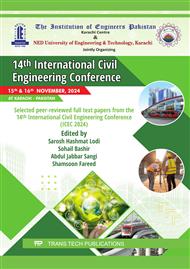p.19
p.27
p.43
p.51
p.61
p.73
p.81
p.91
p.101
The Impact of Silica Fume on the Properties of High-Strength Concrete: Enhancing Strength, Workability, and Durability
Abstract:
Concrete is a fundamental component of many structures and the backbone of the construction industry. While normal-strength concrete is typically used for smaller projects, high-strength, and even ultra-high-strength concrete are increasingly employed in large-scale construction. This type of concrete provides greater structural strength and reduces costs by minimizing the size of structural members compared to normal-strength concrete. High-strength concrete offers additional benefits such as enhanced durability, reduced permeability, and improved resistance to environmental conditions. High-strength concrete can be produced using various admixtures, including fly ash, silica fume, sugarcane bagasse, and rice husk ash. This study focuses on developing high-strength concrete suitable for high-rise buildings and infrastructure projects. This research used silica fume as a partial replacement for cement in varying proportions (5% to 15% by weight) along with highlighting the optimal percentage of silica fume replacement to achieve best performance. The mix designs utilized Sargodha and Margalla crush aggregates, with water-to-cement ratios ranging from 0.30 to 0.35. Concrete samples were cast and tested to evaluate key properties, including compressive strength, tensile strength, workability and modulus of elasticity. The study shows that incorporation of silica fume in high-strength concrete significantly enhances its mechanical properties, including workability, compressive strength, and tensile strength. The results showed marginal improvements in the modulus of elasticity as the silica fume content increased. By using high-strength concrete, designers can reduce material usage due to smaller member sizes, making it particularly valuable for high-rise buildings, long-span bridges, and offshore structures. The research concludes with recommendations for future work and further applications.
Info:
Periodical:
Pages:
61-70
Citation:
Online since:
April 2025
Price:
Сopyright:
© 2025 Trans Tech Publications Ltd. All Rights Reserved
Share:
Citation:


